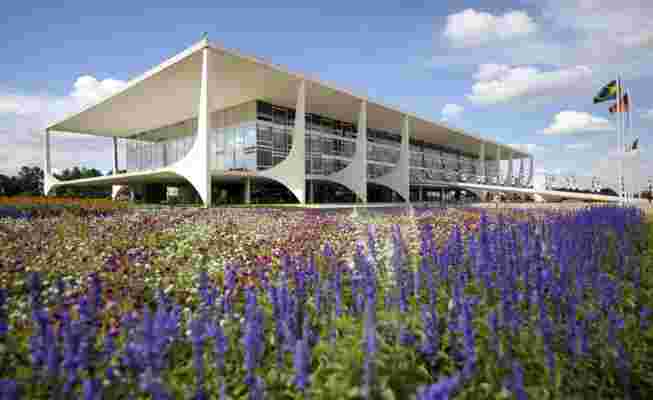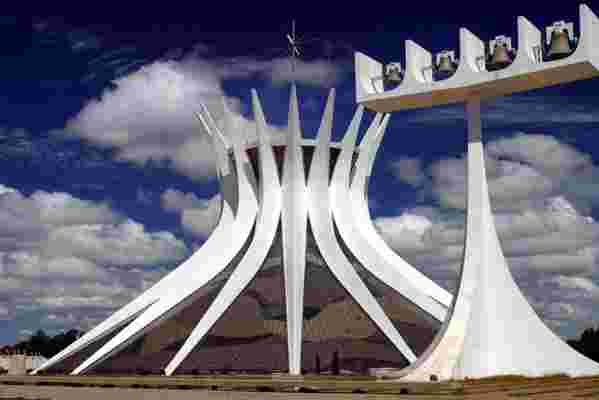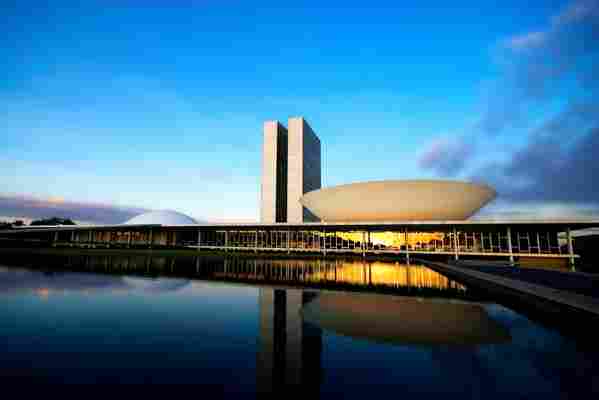In 1956, the newly elected president of Brazil, Juscelino Kubitschek, visited architect Oscar Niemeyer at his home in Rio de Janeiro . There, in the modernist house with a swooping white roof known as Casa das Canoas, Kubitschek proposed this: to make real the long-discussed idea of moving the country’s capital out of Rio, with its colonial past, to the more centrally located Brasília. To futher legitimize the move, the new capital city would include a flurry of new Niemeyer-designed buildings to boot. The famous architect accepted, and was soon joined by Lúcio Costa (another famous Brazilian architect), who would devise the city plan, and Roberto Burle Marx, who would be in charge of the landscape design. What resulted, when the city was inaugurated just four years later, was a sprawling new metropolis mapped around a governmental plaza that would become a beacon of modernist aesthetic ideals.

The Brazilian presidential palace or Planalto Palace, designed by Oscar Niemeyer and located in Brasília.
Three Powers Plaza, located in the middle of the main strip called Monumental Axis, became home to three of Niemeyer’s white concrete structures: the Supreme Federal Court, the presidential palace, and the National Congress of Brazil building.

Completed in 1970, the Cathedral of Brasília was designed by Oscar Niemeyer.
The Supreme Federal Court building, which is encased in glass, sits atop a platform that appears to float and is set within a wavelike colonnade. The presidential palace was designed in much the same way, with a whimsical design that's made all the more powerful with reflections on the building produced from a body of water that's next to the building. The National Congress building features two towers juxtaposed by a long, low structure crowned with a dome, under which the senate works, and a concave disc over the Chamber of Deputies. Shortly after the buildings were completed, Niemeyer was appointed head of the college of architecture at the University of Brasília.

The National Congress of Brazil building in Brasília.
In 1965, after a military coup d'état affirmed Humberto de Alencar Castelo Branco as dictator of the country, the socialist-leaning Niemeyer resigned from his position at the university in protest and left for France. He would not return for 20 years. In 1970, while he was gone, two of his most impressive buildings were finished: the Cathedral of Brasília, a conical hyperboloid structure with soaring white columns, and the Itamaraty Palace, a building dedicated to foreign affairs and designed with a series of arches surrounding a glass structure, also meant to echo the Supreme Federal Court design.
The Itamaraty Palace, which was designed by Oscar Niemeyer, took ten years to complete, as construction began in 1960 and ended in 1970.
Niemeyer returned after the fall of the dictatorship in 1985, and two years later, in 1987, completed the city’s Memorial of Indigenous Peoples, a cylindrical museum for honoring cultural artifacts. Also that year, Brasília was designated a UNESCO World Heritage Site for its visionary architecture and planning. And a year after that, Niemeyer received the prestigious Pritzker Prize.
Fast-forward to the early aughts, when he added the Attorney General’s office building in 2002 and the Cultural Complex of the Republic in 2006, a plaza that included the domed National Museum of the Republic and the modular National Library of Brasília. By the time he passed away in 2012 at the age of 104, his legacy as the brilliant architect of Brazil’s gleaming capital city—and his position in the world of architecture as a master of modernism—was solidly in place.
